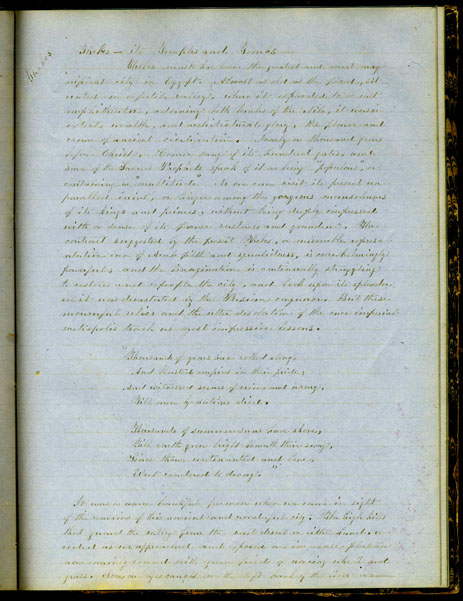Travel
Diary of Mrs. R.P. Eaton:
Europe,
Egypt, and Palestine, ca. 1857

(Thebes)
Thebes – its Temples and Tombs –
Thebes must have been the greatest and most magnificent city in Egypt.
Almost as old as the flood, situated in a fertile valley, where it expanded
to a vast amphitheater, adorning both banks of the Nile, it was in extent,
wealth, and architectural glory, the flower and crown of ancient civilization.
Nearly a thousand years before Christ, Homer sang of its hundred gates,
and some of the sacred prophets speak of it as being “populous,”
or containing a “multitude.” No one can visit its present
unparalleled ruins, or linger among the gorgeous mausoleums of its kings
and princes, without being deeply impressed with a sense of its former
vastness and grandeur. The contrast suggested by the present Thebes, a
miserable representative even of Arab filth and squalidness, is overwhelmingly
powerful; and the imagination is continually struggling to restore and
repeople the city, and look upon its splendor or it was devastated by
the Persian conqueror. But these mournful relics and the utter devastation
of the once imperial Metropolis teach us most impressive lessons.
“Thousands of years have rolled along,
And blasted empires in their pride;
And witnessed scenes of crime and wrong,
Till men by nations died.
Thousands of summer-suns have shone,
Till earth grew bright beneath their sway,
Since thou, untenanted and lone,
Went rendered to decay
It was a warm beautiful firemorn when we came in sight of the remains
of this ancient and wonderful city. The high hills that guard the rally
from the vast desert on either hand receded as we approached and opposed
an immense plateau now mainly covered with green fields of waving wheat
and grass. Soon our eyes caught over the left bank of the river a small